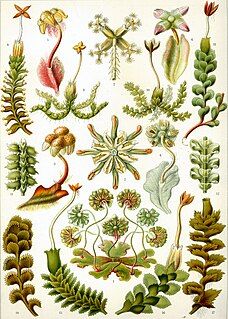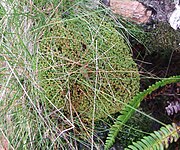
The Marchantiophyta are a division of non-vascular land plants commonly referred to as hepatics or liverworts. Like mosses and hornworts, they have a gametophyte-dominant life cycle, in which cells of the plant carry only a single set of genetic information.

Lunularia cruciata, the crescent-cup liverwort, is a liverwort of the order Marchantiales, and the only species in the genus Lunularia and family Lunulariaceae. The name, from Latin luna, moon, refers to the moon-shaped gemmacups.

Bryology is the branch of botany concerned with the scientific study of bryophytes. Bryologists are people who have an active interest in observing, recording, classifying or researching bryophytes. The field is often studied along with lichenology due to the similar appearance and ecological niche of the two organisms, even though bryophytes and lichens are not classified in the same kingdom.

Schistostega pennata, also called goblin gold, Dragon's gold,luminous moss or luminescent moss, is a haplolepideous moss (Dicranidae) known for its glowing appearance in dark places. It is the only member of the family Schistostegaceae.
Helodium blandowii, also known as Blandow's helodium moss, Blandow's tamarisk-moss, Blandow's bogmoss, and Blandow's feathermoss, is a rare plant in the Western U.S., including Oregon and California. It occurs all around the northern hemisphere in higher latitudes, and in some places is not as rare as in the Western U.S.

Meesia triquetra, the three-ranked hump-moss, is a moss that occurs all around the northern hemisphere in higher latitudes.

Tetraphidaceae is a family of mosses. It includes only the two genera Tetraphis and Tetrodontium, each with two species. The defining feature of the family is the 4-toothed peristome.

The flora of Scotland is an assemblage of native plant species including over 1,600 vascular plants, more than 1,500 lichens and nearly 1,000 bryophytes. The total number of vascular species is low by world standard but lichens and bryophytes are abundant and the latter form a population of global importance. Various populations of rare fern exist, although the impact of 19th-century collectors threatened the existence of several species. The flora is generally typical of the north west European part of the Palearctic realm and prominent features of the Scottish flora include boreal Caledonian forest, heather moorland and coastal machair. In addition to the native varieties of vascular plants there are numerous non-native introductions, now believed to make up some 43% of the species in the country.

Hypnum cupressiforme, the cypress-leaved plaitmoss or hypnum moss, is a common and widespread species of moss belonging to the genus Hypnum. It is found in all continents except Antarctica and occurs in a wide variety of habitats and climatic zones. It typically grows on tree trunks, logs, walls, rocks and other surfaces. It prefers acidic environments and is fairly tolerant of pollution. It was formerly used as a filling for pillows and mattresses; the association with sleep is the origin of the genus name Hypnum.

Pellia epiphylla is a species of thallose liverwort. It occurs in North America, Europe, North Africa and parts of Asia. It grows in patches in damp, sheltered places on neutral or acidic substrates. It is common on the banks of rivers, streams and ditches and also grows in wet woodland, marshes and on wet rocks.

Bartramia pomiformis, the common apple-moss, is a species of moss in the Bartramiaceae family. It is typically green or glaucous in hue, although sometimes it can appear yellowish. The stems extend from a half cm to 8 cm, with narrowly lanceolate to linear-lanceolate leaves 4 - 9 mm long. The leaves have a nerve and are toothed. They are curled when dry but stick out when moist.

Calliergon cordifolium is a species of moss in the Calliergonaceae family, commonly known as the calliergon moss or heart-leaved spearmoss. The species is abundant in the right habitat, and grows in marshes and wet woodland, especially woodland of alder (Alnus) or willow (Salix), as well as around streams, ditches and pools. The species grows in tufts among other moss species. Calliergon cordifolium requires a wet environment to grow, and often grows completely submerged in water. It typically prefers lowland, but has been recorded as high as 910 metres (1,000 yd) above sea level in Inverness, Scotland. The species has a circumpolar Boreo-temperate distribution. It is found throughout Europe. It has been recorded in north and central Asia, as well as Turkey and Japan, throughout North America and in New Zealand.

Sphagnum fuscum, the rusty bogmoss or rusty peat moss, is a peat moss found commonly in Norway and Sweden, and can be found scattered across North America, the United Kingdom, and in southern to eastern Europe.

Ptilidium ciliare is a liverwort with the common names ciliated fringewort and northern naugehyde liverwort. It is widespread in Canada, Alaska, the northeastern United States, Greenland, Iceland, and northern Europe occasionally as far south as northern Italy.

Racomitrium lanuginosum is a widespread species of moss found in montane and arctic tundra across the Northern and Southern hemispheres. It grows as large mats on exposed rock and in boulder scree, particularly on acidic rocks. Its leaves have a characteristically decurrent and toothed hair-point, which gives rise to its regional common names woolly fringemoss, hoary rock-moss and woolly moss.

Pogonatum urnigerum is a species of moss in the family Polytrichaceae, commonly called urn haircap. The name comes from "urna" meaning "urn" and "gerere" meaning "to bear" which is believed to be a reference made towards the plant's wide-mouthed capsule. It can be found on gravelly banks or similar habitats and can be identified by the blue tinge to the overall green colour. The stem of this moss is wine red and it has rhizoids that keep the moss anchored to substrates. It is an acrocarpous moss that grows vertically with an archegonium borne at the top of each fertilized female gametophyte shoot which develops an erect sporophyte.

Metzgeria furcata, the forked veilwort, is a frequent liverwort growing on the bark of a wide range of tree and shrub species and occasionally on rocks. It is a slim, translucent thallose liverwort forming yellow-green mats of branches about 1mm wide.

Rhizomnium punctatum, also called dotted thyme-moss, is a small species in the genus Rhizomnium.

Marchesinia mackaii, or MacKay's pouncewort, is a species of leafy liverwort.
Petalophyllum, or petalwort, is a genus of liverworts in the order Fossombroniales.




















